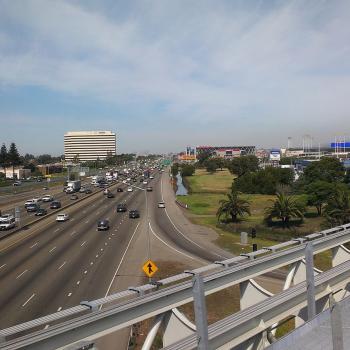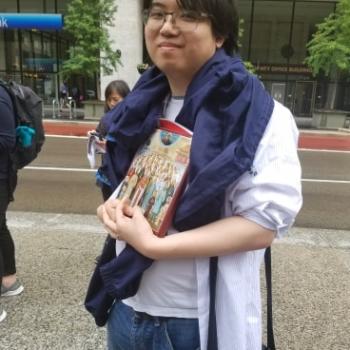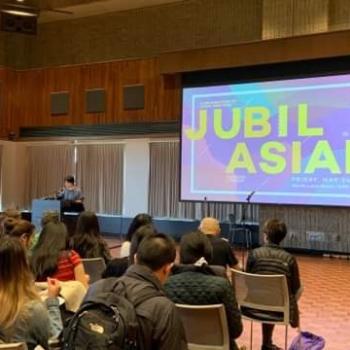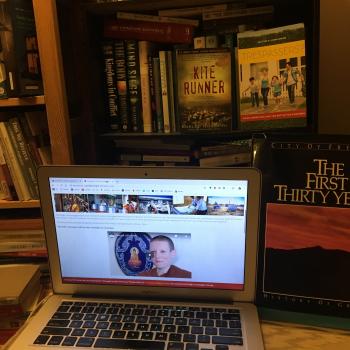![James Baldin taken Hyde Park, London, 1969 - by Allan Warren (James_Baldwin_37_Allan_Warren.jpg) (CC BY-SA 3.0 [https://creativecommons.org/licenses/by-sa/3.0/deed.en]), via Wikimedia Commons](https://wp-media.patheos.com/blogs/sites/721/2013/08/James_Baldwin_37_Allan_Warren-1024x925.jpg)
When I was sixteen, I read a book titled The Fire Next Time. I figured that since it’s James Baldwin’s birthday today, I should put something up on the Thing in commemoration of this event. In fact, since I promised in a previous post on the George Zimmerman verdict that I would write about the immense impact that Baldwin’s work has had on my thinking, consider this a promise fulfilled.
When I was in high school, I did not know that the ‘model minority’ stereotype was the archetypal concept against which Asian American studies was positioned. The ‘model minority,’ for those who aren’t in the know, was a concept developed in the 1960s by white sociologists and journalists who observed that–in their view–Asian people responded to racism differently from black people. While black people were hitting the streets in civil rights protests and arming themselves with the Black Panthers, this stereotype considered Asian Americans to be a ‘model’ minority who focused on the integrity of their private spheres–their strict family life, their hard work in the private sector (usually mom-and-pop shops), their emphasis on education–to overcome racial barriers in America. While Asian American studies was formed through Asian Americans joining in solidarity with African American strikers on university campuses soon after ‘model minority’ articles hit issues in U.S. and World Report and Newsweek, the model minority stereotype was also embraced by a good many other Asian Americans, not least S.I. Hayakawa, the Japanese American university president against whom the black and Asian students were striking on the San Francisco State College campus. By the 1980s, Asian American scholars noted that an increasing number of their students were using the ‘model minority’ to construct their own identities, and many complained about the internal psychological contradictions, the apathy for poor Asian Americans, and the disdain for Chicana/o and African American populations that were the concrete consequences of buying into this stereotype. Indeed, one could say that the use of the ‘model minority’ ideological stereotype in the 1960s had succeeded in positioning Asian Americans as a wedge between white America and peoples of colour who were not Asian, often with devastating consequences for Asian Americans in late 1980s and 1990s urban race riots.
Not knowing any better at the time, though, I considered myself part of the model minority. I lived in California at the time, and if you know anything about the University of California system, what you know is that there are things called ‘UC credits’ that the university uses to evaluate whether certain high school courses can be said to prepare one for admission to the UC system. Intent as I was on getting into a UC school–for the record, I was admitted into four of them, but chose to move out of state, and indeed, out of country, for my university education–I decided to drop home economics. ‘Home ec,’ you see, was not a UC-credited course. But Twentieth-Century Literature was. So I replaced ‘home ec’ with ’20th-century lit,’ and ended up taking two English courses during that term, one an honours English course in which we studied American literature, the other this 20th-century lit course. Needless to say, I was very sleep-deprived during that semester.
I did not know that I would actually get much of what I mull over now out of 20th Century Lit. After all, if it weren’t for that course, I would never have read Thomas Mann, Nadine Gordimer, Dorothy Parker, Carson McCullers, Tennessee Williams, Salman Rushdie, or Flannery O’Connor. As we explored the 1920s, the teacher handed out photocopies of Alain Locke’s The New Negro, and we spent a month combing through the work produced during the Harlem Renaissance. Langston Hughes became a household name. (I didn’t realize this until now, but during that same time, I was taking another course called ‘the Bible as literature,’ and we read Alice Walker’s The Color Purple there.)
It’s in that context that the teacher put a book on our desks quite late into the semester. It was James Baldwin’s The Fire Next Time.
I remember reading it and having no idea what Baldwin was talking about. In the first part of the book, Baldwin writes a letter to his nephew, telling him that generations of black self-hatred should not be blamed on African Americans but on a system of segregation in America in which white America systemically induced a sort of African American subservience that, if undermined, would cause a radical shift in the nation’s constitution itself. As a ‘model minority’ Chinese American, I connected with none of that. After all, we Asian Americans weren’t victims of racism, I thought. We were doing quite well economically. And if we could do it, couldn’t everyone else?
It was to my dismay that the teacher announced soon after this book was assigned that we had to write a poem in response to this book. How was I supposed to write a book about a poem with which I had no connection? I mean, by this point, my father had already been ordained by the African American Progressive Baptist denomination. Unlike other Asian American families, ours was in contact with African Americans working for racial justice in Oakland. I had African American friends in high school who spoke out incessantly against racism in all of its visceral forms, and I actually listened to black gospel music. But I was not black. I was an Asian American, and a damn good model minority one too (I had a 4.39 GPA in high school, if you can wrap your head around that). My African American friends should be the ones writing the poem, I thought, not me.
It was then that I re-read the second part of the book. I must have really fallen asleep on my first time through; either that, or I was just really confused. Baldwin writes his autobiography in the second part, tracing his time as a teenage preacher in an African American Pentecostal church and then his being introduced to Elijah Muhammad and Malcolm X in the Nation of Islam. The first time through, I must have been bewildered–given my encounters with black Christianity–that African Americans could be Muslim. I was probably so weirded out that I completely missed what Baldwin was saying.
The poetry assignment forced me to re-read part 2. Of course, I re-read part 1 too, but that was short–like 10ish pages. Part 2 is this monster of like 100 pages.
And then, just as Baldwin titles the first part, ‘my dungeon shook.’
Re-reading part 2, I began to see parallels to the Chinese churches in which I had grown up in both Baldwin’s account of his Pentecostal preaching and in his ambivalent relationship with the Nation of Islam. Writing of his preaching, Baldwin pretty much says that he was giving his congregation a Marxian ‘opiate of the masses,’ encouraging them as black people to embrace their subservient conditions while looking forward to life in the world to come, to not care about their material conditions and focus on the ephemerally spiritual. In the second part of the book, though, Baldwin issues a different warning about Elijah Muhammad. Baldwin writes of how he admires that the Nation of Islam wants to construct a sort of black nationalism that views ‘black as beautiful.’ However, this comes at one expense: Elijah Muhammad just keeps on throwing out epithets about ‘white devils,’ demonizing white people as the other just as they demonized black people. Baldwin says that that kind of thing insidiously reinforces segregation–keeping the white and black parts of America hating each other and thus dwelling in separate communities–and he says that if those forces of mutual hatred are not dealt with, there will be a racial apocalypse, a judgment on America in which the races will try to kill each other. That judgment, as he quotes the spiritual, evokes a visceral biblical image: ‘God gave Noah the rainbow sign; no more water, the fire next time.’
In many ways, this paralleled my experience of Chinese churches. In private circles not too unlike Baldwin’s dinner meeting with Elijah Muhammad, anyone who was not Chinese was called a ‘ghost’ and a ‘barbarian,’ be they white, Chicana/o, or black. In fact, I heard some even speak of non-Chinese Asians as somehow inferior to the Chinese, be it the Japanese (for the events of the Second World War) or the Filipina/os (for their otherness to Chinese, probably starting with skin colour and then descending into all manners of stereotypes that I cannot bear to repeat on this blog). Hell, even the Chinese from the People’s Republic of China were demonized for being Communists. And yet, unlike the Nation of Islam’s focus on material conditions, our Chinese churches focused on becoming ‘truly spiritual,’ casting off worldliness for the life of the spirit. This had an ironic effect, of course, for our affluent congregations. In church, the focus was on being spiritual, but in the world, we had to get ahead: we had to have 4.5 GPA (mine was considered low, compared to some of my peers), we had to get a 1600 on the SAT I (in those days, there were only verbal and math scores), and we had to aim for economic success in practical careers. I found out later that there was theological justification for this sacred-secular divide: the longtime pastor at our Chinese church regularly declared from the pulpit, ‘Where Christianity is, there is prosperity!’ Focus on God and being spiritual, the ideology went, and you would become economically prosperous with God’s blessing. Opiate of the masses?
As I saw these parallels, I wrote a poem called ‘A Chinese Church’ that eventually became the first thing I ever published (I put it in the literary magazine I founded at the high school; yes, I founded it). I imagined that in the midst of all of this, I might be dating a white girl, and I called her ‘Abbey.’ I even posited that she was a missionary’s kid who spoke Chinese; I never imagined that I’d actually meet white women who could speak Chinese better than I (e.g. Not a Dinner Party), and for the record, I am happily married now to a Chinese woman who is a free-church evangelical. But anyway, for the sake of responding to The Fire Next Time, I imagined bringing Abbey to a Chinese church. She would get all kinds of strange glances as a ‘ghost,’ weird stares as a ‘barbarian,’ and a stream of people telling her, ‘This is a Chinese church; how can I help you?’ I ended the poem with a zinger: having left the church, gotten married, and gotten Abbey pregnant with a half-white, half-Chinese child, the speaker (well, that is, me) declared, ‘They were a Chinese church; could they help us?’
The poem was a hit. As I said, I got it published in the literary magazine (well, I was the founding editor, so it had to go in there, but it got some good responses). It was also awarded 100% as its grade, which helped my 20th Century Lit overall score and my 4.39 GPA.
But I never imagined that ten years later working on a PhD on Chinese Christians, I’d still be mulling over The Fire Next Time or that my poem, which was written with fairly instrumentalist motivations, would still be lingering in the back of my head. Of course, a lot has happened since then, my thinking on the Chinese church has (hopefully) matured, and I (thankfully) did not end up marrying a white missionary girl named Abbey.
But on this commemoration of James Baldwin’s birthday, I want to thank James Baldwin for shaking my ‘model minority’ dungeon.
Indeed, shortly after writing this poem, we were assigned in AP US History to do a project on a topic of interest to us. Having done some research and discovered a film by Justin Lin called Better Luck Tomorrow, I decided to research the ‘model minority,’ and that was the first time that Asian American academic names like Ronald Takaki, Sucheng Chan, and Roger Daniels came onto my radar screen. But I don’t think I actually got it until my doctoral work when I embarked into a sustained reflection on Asian American studies and its protest of orientalizing racialization throughout American history.
It was then that I discovered that the way that most people who criticize Chinese churches often misses the mark. Critiqued as bulwarks against racial integration and strongholds of conservative patriarchal ideologies, it has simply never occurred to most people that Baldwin’s analysis of both the black church and the Nation of Islam might have any application to Chinese Christianity. It does.
And here’s the application.
It is that ‘Asianness’–and ‘Chineseness’ in particular–has to be continually constructed within Chinese churches to preserve their place as the model minority within a black-white racial hierarchy. ‘Asianness’ and ‘Chineseness’ don’t imprison Chinese churches; Chinese Christians themselves actively construct a unitary ideology of what these things are in order to hang on to their wedge position as the ‘model minority.’ This is not just confined to America. A recent example of this is the attempt in Hong Kong by some Chinese Christians uninterested in making these constructs to hold others who are interested in these power dynamics accountable for their claims about trying to find Noah’s Ark in Turkey. For those who aren’t in the know, an organization in Hong Kong has solicited funds from Chinese churches over a decade in an effort to find Noah’s Ark as a silver bullet for convincing the world of the inerrancy of Scripture, which they claim will result in a major proselytizing harvest. In the process, dubious actions have been committed, especially the exaggeration of results from their Turkey expeditions (on which no credible archaeologists went). While my friends like Sam Tsang have been pressing for truth in this matter, the response tends to be that the dissenters calling for accountability will shatter the construct of a universal Chinese Christianity that needs to speak with one voice for evangelistic effectiveness. In other words, there’s too much riding on some Chinese Christians wielding the power to construct ‘Asianness’ and ‘Chineseness,’ so much that dissent is suppressed. Allow the dissent, and shatter the community.
Baldwin warns us precisely of this kind of thing. He reminds those of us Asian Americans who buy into the ‘model minority’ stereotype that, by corollary, this construct that from its very inception was meant to situate Asian Americans as a wedge between black and white America is designed to feed segregation and hatred, whether those of us who used it for our identity construction know it or not. In other words, buying into ‘model minority’ constructs may not be accompanied by known malicious intentions, but the structural social consequences of buying into it result in hateful polarization. The horror is not simple theological and organizational breakdown within Chinese churches and among Chinese Christian networks. It’s that they will feed the racializing processes that keep the races segregated from each other in mutual fear and hatred, a problem that, as we saw in the Trayvon Martin case, is just as insidious today as it was when Baldwin was writing. It’s those constructs that must be the target of any prophetic critique. Those of us making this critique love the Chinese church. We grew up in it. We were spiritual formed by it. Our closest friends and family are part of it. But we criticize not because we either hate the church and not because we are simply trying to save a structure that we, and no one else, care about. We speak because we pray that Chinese Christians would be shaken from our complicity with racial segregation and realize that the ‘Christian’ thing calls us to contribute our very selves to the church catholic’s ministry of reconciliation.
Indeed, as Baldwin concludes The Fire Next Time, reconciliation can only happen when the demonization stops and the power of love conquers the consolidation of segregated communities. To posit a heterodox reading of The Fire Next Time via a radically orthodox Christian lens, the fire next time can only be avoided by the Cursillo prayer: ‘Come, Holy Spirit, fill the hearts of your people and kindle in them the fire of your love.’ James Baldwin has spoken to us, and his words are prophetic. We are called to repentance; we are summoned to examine our contribution to the impending racial apocalypse; we are beckoned to follow the way of love over against structures that feed hatred and division. Though James Baldwin left the pulpit early on in his ministry and thought that he left the Body of Christ, Baldwin calls us to follow the way of Christ, a way that shattered my dungeon and has moved me in a vocational direction that I never imagined I would take when I was sixteen. All I can say is that I am grateful to Baldwin for writing his book, and I hope that my work does his legacy justice.











